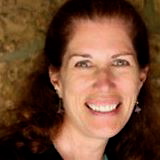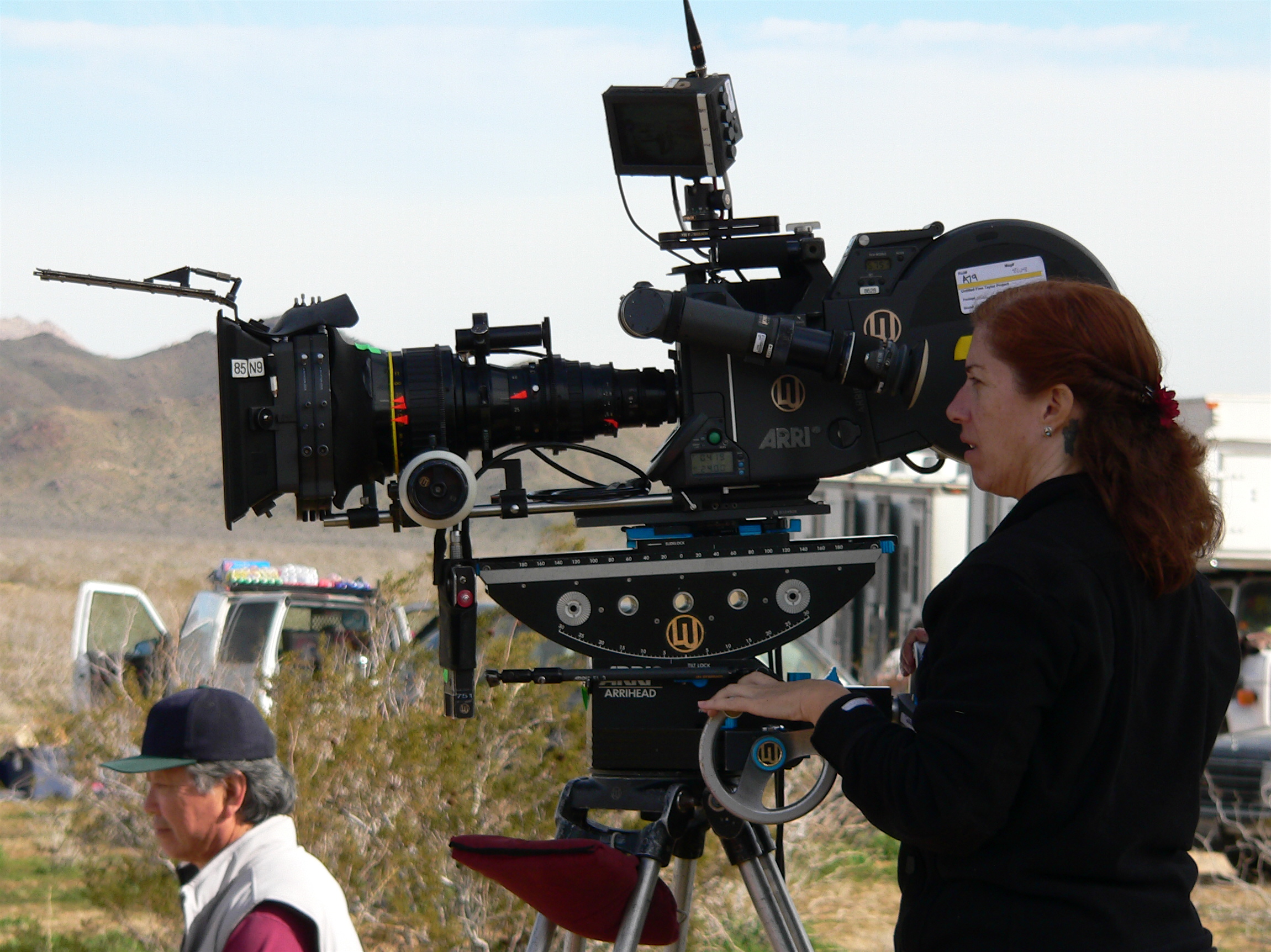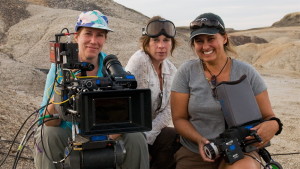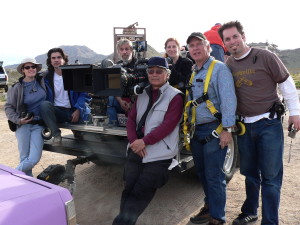Pre-visualization
Veteran camera operator Georgia Packard began her life behind the camera as a child taking summer classes with Ansel Adams. Yes, the Ansel Adams.

Camera operator Georgia Packard
“Ansel Adams was such a wonderful mentor,” Packard says, “teaching me pre-visualization in his still photography. We would go out with a pin-hole ‘camera’ shoebox with only one exposure. I knew I had to get it right the first time! I walked around my subject looking high and low, moving far left and right before releasing the cap.”
The lessons stayed with Packard. “I still do that on my film sets, watching where the actors move and often from where the director is watching the scene. This works really well when there are two cameras shooting the scene together so I can offer up my camera’s position.”
Packard now has a long list of film and television credits, including Austin Powers: The Spy Who Shagged Me, The Avengers, Valentine’s Day, MacGruber and Seinfeld.
Cameras
On set, Packard works to keep up with evolving camera technologies. “The camera operator needs to know about the workings of many different cameras – film and digital, plus several of the ‘still’ cameras we are using.” Packard’s own preference is film. “I believe in film. Working in film allowed me to have a very tactile experience, putting my hands on the film stock and inside the cameras. Film cameras are mechanical and teach a great A-B-C problem-solving thought process that gives you immediate feed-back. I learned how to change boards, tech the camera gear, and think one step ahead out of necessity.”
For Packard, a film camera offers a unique experience. “The process of working with a film camera focuses the crew in front and behind the camera. When ‘Roll camera’ is called, everyone concentrates on the process of making the shot. ‘Action’ signals the actors (and sometimes a dolly/crane move) to move forward together from the very beginning.”
Packard notes that digital filmmaking brings a different experience. “…(W)hen using digital/tape, once the camera is rolling (with connected sound), the actors often stop and start, or repeat and shift positions without resetting camera/sound/props. I understand when the director doesn’t want to stop or turn off camera because of the double-checking of hair and makeup or having to take the time for re-slating.”
However, she feels there can be a downside to keeping a digital camera rolling. “The cost of this ‘silent rolling’ is the crew has little opportunity to reset, to anticipate and lead the action with confidence. This does create a ‘style’ which people call ‘documentary’ (or winging it) and often has the operator hand-hold and relocate with the actors’ actions.”
“Digital cameras,” she says, “are ‘computers’ which often need time to reset while the entire set waits for your reboot.” Her advice to the operator: “Stay calm. Use the time to double-check what needs to happen for the shot.”
Documentary Camera Work
Packard started in documentary camera work as a focus puller, “This was a fun challenge working my focus in a ‘zone’ or distance range. I rarely worked with an assistant’s onboard monitor so I had to be one with my operator (often Emiko Omori) listening to the sound the film made as it went through the gate and therefore telling me its speed and fluidity as it traveled through the gate. I love that sound. You know when the camera is on/off, when you need to be on/off. The digital cameras are not signaling their ‘turn over’ to the rest of the crew,” says Packard.
She also points out that the camera operator has a close relationship with the boom operator, which will ensure capturing good sound and keeping the microphone out of the frame.
You can’t afford to be distracted.
“Digital cameras have fans that are very loud and hot for the operator’s right ear. On long takes it gets challenging to stay close to the camera. And you can’t afford to be distracted – actors may have another take but the crew must perform perfectly each time. If something wrong happens during the take, the operator must be able to quickly communicate what needs to be changed and where in the take (if a partial or a whole new take must be made). Giving a solution can often be helpful to keep the momentum moving forward with minimum delay.”
“It really doesn’t matter what camera we shoot with; a camera is a camera is a camera that captures light onto a recording device which is edited together, compositing many layers of elements in sound and picture. I am thrilled seeing all of the production’s challenges come together in the final show. I love being in the dark, watching a projector flicker up on a screen where I can play everybody in the story, identifying with each character’s arc for two hours while I leave behind my own life at the theatre’s door.”
Packard’s experience in TV
“I started working Seinfeld as an assistant when there were three cameras used for the show,” Packard says. While she was on the show, she says that they added a fourth camera to shoot some scenes in advance so they can be screened for the live audience attending the last night of filming the episode. Many times these will be exterior scenes or ones using unpredictable stunts, kids, or animals.
“I trained the fourth camera operator in the sitcom mode (on Seinfeld). Working as an assistant was so helpful to understand what the operator’s role is and how to interface with the dolly grip and boom. The operator is the captain of their camera and needs to work with the rest of the crew: hair, makeup, sound, costume, props, lighting, grips, special effects, etc.”

Packard behind the camera
“Moving up to the operator position, I now concentrate more on the director’s vision with the actors’ performances. I rely on my assistant to handle most of the technical – and it really helps when you understand what you are requiring from the gear, and how long it takes your assistants to perform the tasks.”
You always have to protect the frame.
“You have control over what is seen in the scene and what isn’t. You always have to protect the frame. Yet if you act as if you are the only one creating the shot, you will find yourself on a celluloid island filled with anxiety. My background with documentary and stunt work prepared me for operating the camera with the actors’ actions. Physical comedy can be very broad, which often takes the actors off their marks, lighting and camera positions – where we shoot several pages without stopping.”
“Many of our camera moves are with line cues, often swinging set walls and opening doors and windows so we can shoot through them to get the best angle on the actors. You have to memorize the lines and know where the camera is supposed to be, especially so that when a line is dropped or changed you can realign the camera’s position, lens size and focus. I loved moving up to operator because I was allowed to work next to my operator, Herb Roberts, who was so important for my career. He taught me how to relax while being in that hyper-focus concentration needed on the set. Herb knew so much of the studios’ history and we often played Jeopardy to keep one part of our brains open and ‘in the zone’ while staying in the present.”
Packard says that teamwork on set “…extends to the rest of your crew with a smile and good will. Acknowledge what and when people support the show. You all are a team working together to do the very best you can to capture it on film or digital. No one knows how hard it really was to shoot, or the contortions you needed to do to operate successfully. A good operator makes the work look easy.”
Sculpting Scenes With Her Camera

Packard with Tammy Fouts and Deborah Cottrill: Stargate Universe, New Mexico
Georgia Packard’s career has given her many memorable moments. “Working as a feature film or television show A camera operator is wonderful because I get the chance to develop a relationship with the director and the cinematographer. I am in the driver’s seat taking charge with confidence. Operating B camera with Tammy Fouts as my assistant, handholding the 25-250mm zoom or doing the long lens complimentary shots on StarGate Universe and MacGruber, we kicked butt! Always looking for that angle, looking to get into the rhythm and style that is needed for that particular scene. Really seeing with my mind’s eye while I record ‘reality’ on film or digital. Sculpting with my camera through time and space.
“Trying not to shake the camera because I am laughing so hard as I follow Austin Powers rescuing his penis pump from a Femmebot in The Spy Who Shagged Me. Seeing a wonderfully dressed Shirley MacLaine float across the cemetery lawn in Valentine’s Day while a younger Shirley’s film is projected onto her and the building behind.”
Inspiration and Self-Development
“I love going to see art in museums and galleries, checking out composition/lighting/texture and how I react to what I see. When I look through the lens, there is a reaction to what I see. I play with this by shooting stills in different formats and frame sizes, forcing myself to ‘be one with the shot’ and where it dictates I put the camera.”

Darwin Awards
“I really enjoy working on documentary film. I travel and learn about all kinds of people, culture, and politics. We used this style of operating while filming the 2006 The Darwin Awards (Joseph Fiennes and Wynona Ryder) because the camera operator is also inside the film’s story. What a joy to work with that crew and dance with the camera’s movements where the actors looked directly in the lens; the documentary camera was ‘operated by a cast’ (really me) and so I became interactive with the rest of the cast.
“My assistant Paul Marbury ‘felt’ the flow of the scene with his focus, knowing when and where the audience was supposed to look. Sometimes I would whisper changes or new timings. The bond between the operator and assistant has to be strong with good communication.”
I have to give them a shot that they can use.
Packard says the camera work is “…all about making sure Production has the best pieces in the editing room. I have to give them a shot that they can use, and not necessarily a flashy one or one that gets in the way of the other camera. I worked at University in the Archive Department and as a teacher’s assistant, taking slides off of film prints with a step projector. I used the work to learn editing and what choices the director made in selecting camera positions, rhythm and lengths of the shots, and how sound worked with the picture.”
Honing Your Operator Skills
Packard suggests using your “other” hand or eye to complete a task. “Try chopsticks to challenge your fine motor control. Becoming ambidextrous realigns your body and balances you.”
“Learn to lean forward and into your life at a moment’s notice to quicken your reflexes. Yoga is my daily passion, along with circuit training and hiking. I stretch all day long as an operator. Take any moment in between shots to keep loose. And BREATH! Do you hold your breath when you anticipate? Shoulders shift up to your ears under pressure?”
“We usually have sandbags on the dolly that double as weights. Pushups and planks can be done anywhere. Bring a second pair of shoes to change into because you are on your feet 12 hours straight.”
No Adult Supervision
“I believe we are crafts people, artists working with a variety of mediums. It doesn’t matter what unit or camera I am connected to, I always do my best. Second unit can be really fun because we go out without ‘adult supervision’ or video village’s committee. I speak with the director of photography (if matching or completing a scene) and the director, and write down what their intentions are for my shots. Sometimes I am given a shot list, most times it is a verbal description of the way the shots should ‘feel’.”
Stunt Crews
Packard loves working on stunt crews, traveling on motorcycle sidecars, tow cars, cranes, lifts and helicopters. “Lining up my camera for the best plane of the action without seeing the stunt person’s face on my long lens shot so that you believe it is Cameron Diaz roping the calf at the rodeo in Gambit. Filming a computer-generated werewolf/dog charging into the kitchen of Jesse Eisenberg on Cursed without being able to actually see it’s actions but designing the shot with pauses and leaps anticipating its wild performance.
“I love working ‘team’ and I feel very fortunate that I have such great assistants, dolly grips, boom ops and crew to play with for the shows. They help me look better, keep me challenging myself to do better, and humming gracefully throughout the day.” For Packard, “There is always another exciting story to tell.”
Starting out, keep your eyes open and your mouth shut.
Packard’s advice: “Never let anyone tell you how impossible it is. Don’t let anybody steal your dreams. If you are passionate about your craft, wanting nothing more than getting an opportunity to live your dream, go after it. I often appreciate these warnings of doom because they focus my resolve and I ‘prove them wrong’. You will never know if you can do it unless you do it. Don’t try, do.
“Starting out, keep your eyes open and your mouth shut. Listen, listen, listen and watch. If you do make a mistake (and we all do), own up to it right away so that a solution can be found quickly. You will feel more embarrassed if you don’t speak up and then they tear down the set.”
Her Bags Are Packed
“I often get asked about working with first time directors. I love it. I am not worried about you not knowing what to call something or how a piece of equipment is used. That’s why you hire me. Have a vision. Use your heart. Learn how to tell a really good story. We need good filmmakers. Be sure to call me. There is no show too small to trip the light fantastic. My bags are packed and my passport is tucked into my back pocket. See you on the set.”
See IMDb for a full list of Georgia Packard’s credits.
Here’s a link to Georgia Packard’s film and television credits.
